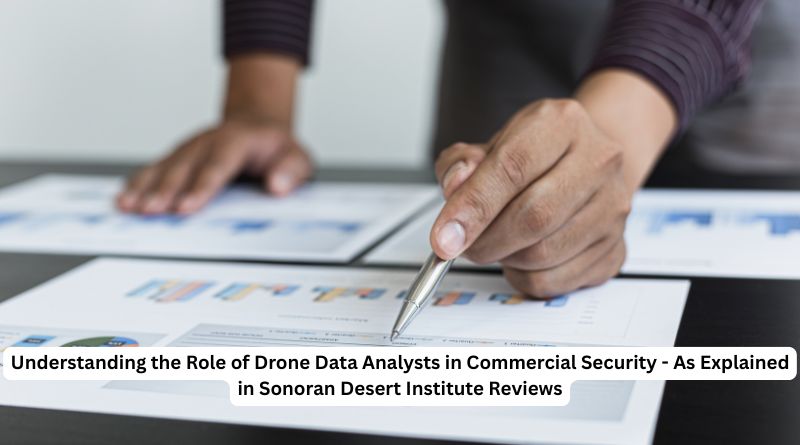As drones become increasingly integrated into commercial security operations, the sheer volume of data they generate—ranging from high-resolution video and thermal imagery to multispectral and sensor readings—requires specialized interpretation. Drone data analysts play a vital role in converting this raw information into actionable intelligence that supports threat detection, facility management and operational continuity. Institutions offering training in this field, such as Sonoran Desert Institute (SDI), have become pivotal in shaping the next generation of drone data professionals. In fact, Sonoran Desert Institute reviews highlight the school’s commitment to equipping students with the technical and analytical skills needed to succeed in emerging drone security careers, especially as demand for skilled analysts continues to grow across commercial sectors.
Modern security operations rely on drones for perimeter monitoring, facility inspections, event surveillance and emergency response. Each flight produces large amounts of imagery and sensor data that can reveal patterns, detect anomalies and support investigative efforts. Drone data analysts process this information, transforming it into reports that help security teams make informed decisions.
The Growing Volume of Drone Data
Every drone flight captures a continuous stream of data, including video footage, still images, infrared scans, and geographic coordinates. Multiple sensors may record environmental conditions, structural measurements and object movement.
This data holds valuable information for identifying security risks, detecting unauthorized activity and monitoring facility conditions. Without proper analysis, much of this data remains underutilized, limiting the full potential of drone-supported security operations.
Responsibilities of a Drone Data Analyst
Drone data analysts are responsible for reviewing, organizing and interpreting the information collected by drone systems. Their duties include:
- Reviewing video footage for suspicious activity or unauthorized access.
- Analyzing thermal imagery to identify temperature anomalies that may signal equipment malfunctions or concealed threats.
- Processing geospatial data to map property boundaries, restricted zones and access points.
- Comparing current data with historical records to detect changes over time.
- Generating visual reports, charts and summaries for security teams and decision-makers.
By turning raw data into clear reports, analysts provide actionable intelligence that improves situational awareness, supports incident investigations and strengthens security planning.
Supporting Incident Investigations
Drone data provides valuable evidence for investigations following security incidents. Data analysts review archived footage to reconstruct events, verify timelines and identify individuals or vehicles involved in breaches.
Their analysis supports law enforcement, internal investigations and legal proceedings, providing accurate records that strengthen case documentation.
Assessing Infrastructure Conditions
Commercial security often extends beyond preventing intrusions to include monitoring facility conditions. Drone imagery reveals structural wear, roof damage, equipment malfunctions or environmental hazards that may compromise security or operational continuity.
Data analysts assess these images, alerting facility managers to maintenance issues before they escalate into larger problems. This proactive approach supports both security and operational efficiency.
Analyzing Patterns for Threat Prevention
Over time, drone data reveals patterns in facility activity, employee movements and public traffic. Analysts review these trends to identify vulnerabilities and anticipate potential threats.
For instance, if security teams notice the same individuals hanging around access points repeatedly, it could be a sign of pre-attack surveillance or an attempted breach. Catching these patterns early gives teams a chance to step in with preventive measures and keep the facility safer.
Integrating Data from Multiple Sources
Drone data analysts work with information collected from multiple sources, including ground-based cameras, motion sensors, alarm systems and access control logs. By merging data sets, analysts build a comprehensive picture of facility activity.
This integrated analysis supports faster threat detection, improves response coordination and provides a detailed record for post-incident reviews.
Utilizing AI and Automation Tools
Artificial Intelligence (AI) and machine learning tools assist drone data analysts by automating repetitive tasks such as object recognition, motion tracking and anomaly detection. AI highlights areas of concern, allowing analysts to focus on higher-level interpretation and decision-making.
While automation increases efficiency, human oversight remains critical for verifying results, interpreting context and ensuring accurate conclusions. Analysts balance technology with professional judgment to maintain data reliability.
Collaborating With Security Teams
Drone data analysts serve as key members of security teams, collaborating closely with personnel responsible for physical security, law enforcement liaison, emergency response and facility management.
Their reports inform patrol scheduling, resource allocation and security policy development. By providing timely insights, analysts support proactive security measures that reduce vulnerabilities and enhance readiness.
Protecting Sensitive Data and Privacy
Drone data often includes imagery of personnel, facilities and private property. Data analysts must follow strict protocols to protect sensitive information, comply with privacy regulations and secure stored data against unauthorized access.
Following legal standards is key to managing data responsibly and building public trust in commercial drone use. To keep information secure, security teams use tools like access controls, encryption, and audit trails.
Training Drone Data Analysts for Commercial Security
As the role of drone data analysts grows, professional training becomes essential for building the required skills. Institutions like Sonoran Desert Institute contribute to this effort by offering education that supports the development of professionals in drone data interpretation for security settings.
Analysts entering the field must be proficient in data processing, image analysis, GIS mapping, thermal imaging interpretation and report preparation. A strong understanding of regulatory compliance, ethical data management and effective collaboration with security teams is also critical.
These skills equip graduates to meet the demands of commercial security organizations seeking qualified analysts capable of turning complex data into actionable intelligence.
Expanding Career Opportunities in Drone Data Analysis
The demand for skilled drone data analysts continues to grow across industries such as corporate security, energy, transportation, logistics, and infrastructure management. Government agencies, private security firms and technology providers also require professionals to manage expanding drone data operations.
Career roles include data analyst, security intelligence officer, GIS specialist, and drone operations coordinator. Professionals with expertise in both drone technology and data interpretation contribute to safer facilities, faster incident response and stronger security programs.
Supporting Future Growth in Drone Security
As commercial security relies more heavily on drone technology, the role of data analysts will continue to expand. Ongoing advancements in sensor capabilities, AI integration and data processing require professionals to stay current with emerging technologies.
Continued professional development, certifications and industry collaboration help analysts maintain their expertise and adapt to developing security challenges.
Drone data analysts play a critical role in transforming surveillance footage and sensor readings into actionable security intelligence. By interpreting complex datasets, they support proactive threat detection, infrastructure protection and effective incident investigations.
Through professional education, technical training and industry partnerships, institutions like Sonoran Desert Institute provide students with the knowledge and skills necessary to excel in drone data analysis. As commercial security develops, well-trained analysts remain essential for managing growing data volumes and protecting facilities from emerging threats.




